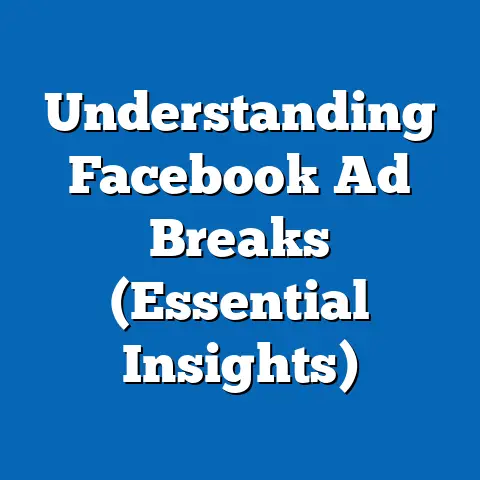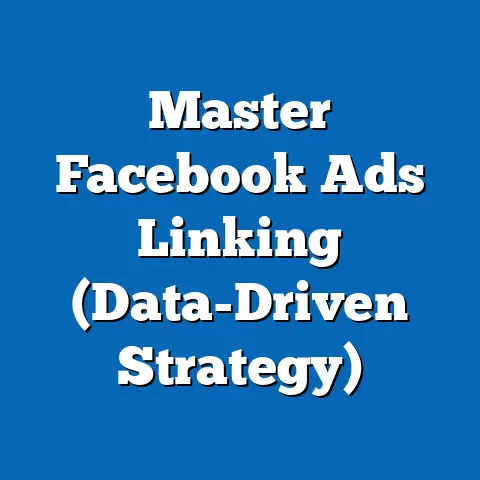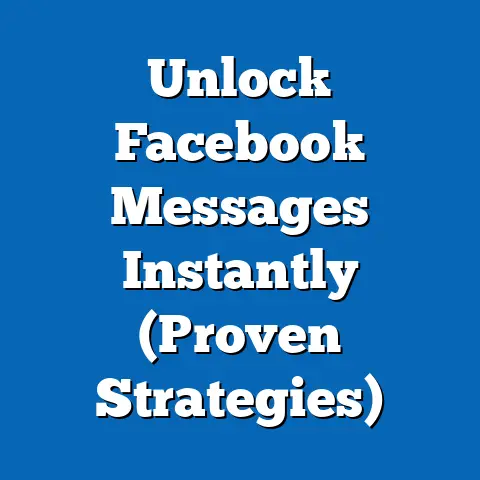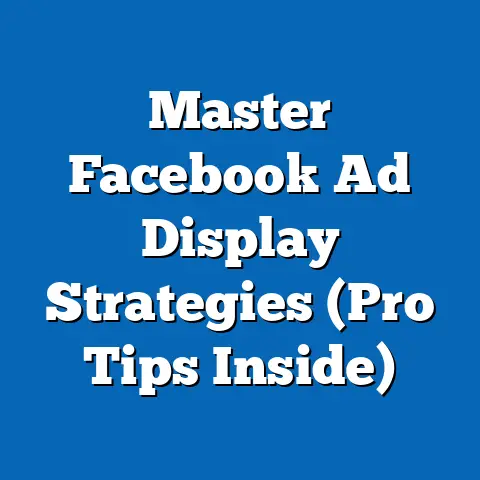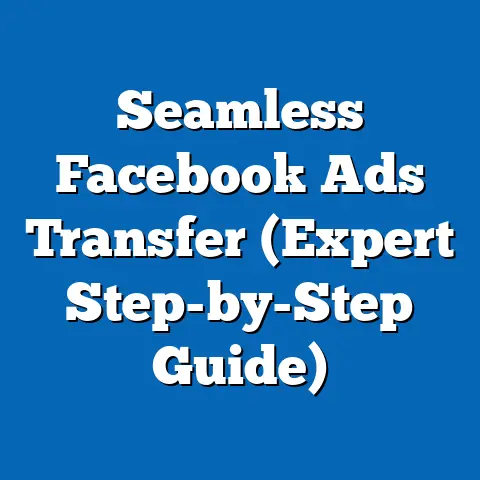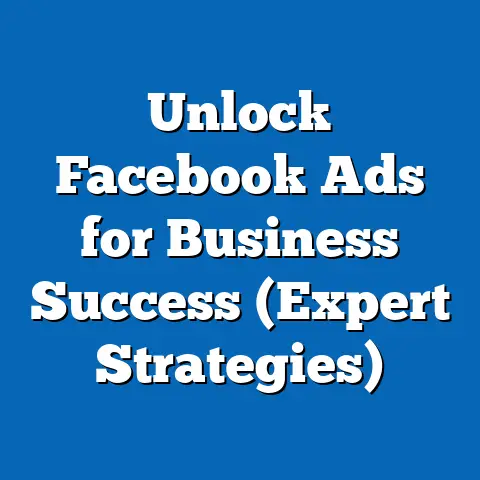Design Own Facebook Ad (Unlock Powerful Strategies)
I remember when I first started dabbling in Facebook advertising; it felt like throwing spaghetti at a wall and hoping something would stick. I was running a small online store selling handmade jewelry, and while I had beautiful products, nobody seemed to notice. I tried everything – posting regularly, engaging with comments, even running contests. But my sales remained stubbornly low.
Then, a friend suggested Facebook ads. “It’s the way to go,” she said. “You can target exactly who you want!” Excited, I threw together a quick ad with a blurry photo and some vague text. The result? Crickets.
That’s when I realized that Facebook advertising isn’t just about throwing money at a platform; it’s about crafting a compelling message, designing eye-catching visuals, and understanding your audience inside and out. It’s about strategic design.
Like the local coffee shop down the street – let’s call it “The Daily Grind.” They have amazing coffee, delicious pastries, and a cozy atmosphere perfect for catching up with friends or getting some work done. Yet, they struggle to attract new customers. They’ve tried flyers, local newspaper ads, even a loyalty program. But the foot traffic remains inconsistent.
The Daily Grind, like many small businesses, needs a targeted boost. Facebook advertising, when done right, can be that boost. But it’s not just about throwing up any old ad. It’s about designing an ad that speaks directly to their ideal customer.
In this guide, I’ll share the strategies I’ve learned over the years – both from my own successes and failures – to help you design Facebook ads that not only get noticed but also drive real results for your business.
The Importance of Facebook Advertising
Facebook, now under the Meta umbrella, isn’t just a place for sharing vacation photos and political rants. It’s a marketing powerhouse with almost 3 billion monthly active users worldwide. Think about that for a second. That’s almost half the planet!
And these aren’t just passive users. They’re actively scrolling, engaging, and discovering new brands and products. According to recent statistics, the average Facebook user spends around 30 minutes per day on the platform. That’s 30 minutes of potential exposure for your brand.
But the real magic of Facebook advertising lies in its unparalleled targeting capabilities. Unlike traditional advertising methods, where you’re essentially casting a wide net and hoping to catch a few fish, Facebook allows you to laser-target your ideal customer based on a vast array of factors, including:
- Demographics: Age, gender, location, education, relationship status, etc.
- Interests: Hobbies, passions, favorite brands, pages they like, etc.
- Behaviors: Purchase history, online activity, travel habits, device usage, etc.
- Custom Audiences: Upload your existing customer list to target people who already know and love your brand.
- Lookalike Audiences: Find new customers who share similar characteristics with your existing customers.
This level of precision means you can show your ads only to the people who are most likely to be interested in your product or service, maximizing your ROI and minimizing wasted ad spend.
For The Daily Grind, this means targeting local residents who are interested in coffee, cafes, and local businesses. They can even target people who have recently moved to the area and are looking for new places to explore.
Takeaway: Facebook advertising offers unparalleled reach and targeting capabilities, making it a crucial tool for businesses of all sizes.
Understanding Your Audience
Before you even think about designing your ad, you need to understand who you’re trying to reach. This isn’t just about demographics; it’s about understanding their needs, wants, and pain points.
Think of it like this: you wouldn’t try to sell snow shovels to people living in Miami, would you? Similarly, you need to tailor your ad messaging and visuals to resonate with your specific audience.
Here are a few methods I use for audience research:
- Analyze Your Existing Customer Data: Look at your website analytics, customer surveys, and CRM data to identify patterns and trends. Who are your most loyal customers? What are their demographics? What are their interests?
- Create Customer Personas: Develop detailed profiles of your ideal customers, including their age, gender, occupation, interests, goals, and challenges. Give them names and even find stock photos that represent them. This will help you visualize your target audience and tailor your messaging accordingly.
- Conduct Market Research: Use online surveys, focus groups, and social media listening to gather insights into your target audience’s needs and preferences. What are they talking about online? What problems are they trying to solve? What are their favorite brands?
- Leverage Facebook Audience Insights: This powerful tool within Facebook Ads Manager allows you to analyze the demographics, interests, and behaviors of people who like your page or are interested in a particular topic.
For The Daily Grind, understanding their audience might reveal that their ideal customer is a young professional who works remotely, enjoys specialty coffee, and values a comfortable workspace. Knowing this, they can tailor their ad messaging to highlight their free Wi-Fi, comfortable seating, and high-quality coffee.
Takeaway: Thorough audience research is essential for creating effective Facebook ads that resonate with your target audience.
Crafting the Perfect Ad Copy
Now that you know who you’re talking to, it’s time to craft the perfect ad copy. This is where you capture their attention and convince them to take action.
Your ad copy should be:
- Clear and Concise: Get straight to the point and avoid jargon or overly technical language.
- Benefit-Oriented: Focus on the benefits of your product or service, not just the features. How will it improve their lives?
- Persuasive: Use strong verbs, compelling adjectives, and social proof to encourage action.
- Relevant: Tailor your messaging to resonate with your target audience and their specific needs.
- Actionable: Include a clear call to action that tells them exactly what you want them to do.
Here’s a breakdown of the key elements of ad copy:
- Headline: This is the first thing people will see, so make it count. Use a strong hook, a compelling offer, or a question that sparks curiosity.
- Example: “Craving the Perfect Coffee? The Daily Grind Has You Covered!”
- Body Text: This is where you elaborate on the benefits of your product or service and provide more details. Keep it short, sweet, and to the point.
- Example: “Escape the ordinary and discover a coffee shop that feels like home. With free Wi-Fi, comfortable seating, and the best coffee in town, The Daily Grind is the perfect place to work, relax, or catch up with friends.”
- Call to Action (CTA): This is the final nudge that encourages people to take action. Use strong, action-oriented verbs like “Shop Now,” “Learn More,” “Sign Up,” or “Visit Our Website.”
- Example: “Visit The Daily Grind Today!”
- Example: “Craving the Perfect Coffee? The Daily Grind Has You Covered!”
- Example: “Escape the ordinary and discover a coffee shop that feels like home. With free Wi-Fi, comfortable seating, and the best coffee in town, The Daily Grind is the perfect place to work, relax, or catch up with friends.”
- Example: “Visit The Daily Grind Today!”
I’ve found that using numbers and statistics can be incredibly effective in ad copy. For example, “Join over 500 satisfied customers who start their day with The Daily Grind!”
Avoid making false claims or exaggerating the benefits of your product or service. Honesty and transparency are key to building trust with your audience.
For The Daily Grind, they could use ad copy that highlights their unique selling points, such as their locally sourced ingredients, their commitment to sustainability, or their friendly staff.
Takeaway: Compelling ad copy is essential for capturing attention, conveying value, and driving action.
Designing Eye-Catching Visuals
In the world of Facebook advertising, visuals are king. People are bombarded with information every day, so you need to grab their attention with something visually appealing.
Your visuals should be:
- High-Quality: Use clear, crisp images or videos that are well-lit and visually appealing.
- Relevant: Choose visuals that align with your brand and your ad messaging.
- Eye-Catching: Use bold colors, interesting compositions, and engaging elements to stand out from the crowd.
- Mobile-Friendly: Optimize your visuals for mobile devices, as most Facebook users access the platform on their phones.
Here are a few tips for creating effective visuals:
- Use Professional Photography: Invest in high-quality photos or videos that showcase your product or service in the best possible light.
- Create Eye-Catching Graphics: Use design tools like Canva or Adobe Spark to create visually appealing graphics that incorporate your brand colors, fonts, and logo.
- Experiment with Video: Video ads tend to perform better than static image ads, as they’re more engaging and can convey more information.
- A/B Test Different Visuals: Test different images, videos, and graphics to see what resonates best with your audience.
Color theory plays a significant role in visual design. For example, blue often conveys trust and stability, while red evokes excitement and energy. Choose colors that align with your brand and the emotions you want to evoke.
For The Daily Grind, they could use photos or videos of their delicious coffee, their cozy atmosphere, or their friendly baristas. They could also use graphics that highlight their special offers or promotions.
I remember one ad campaign I ran where I A/B tested two different images: one with a simple product shot and another with a lifestyle shot of someone using the product. The lifestyle shot performed significantly better, as it helped people visualize themselves using the product.
Takeaway: Eye-catching visuals are crucial for grabbing attention and conveying the value of your product or service.
Setting Up Your Facebook Ad Campaign
Once you’ve crafted your ad copy and designed your visuals, it’s time to set up your Facebook ad campaign. This involves choosing the right campaign objective, setting a budget, and selecting ad placements.
Here’s a breakdown of the key steps:
- Choose Your Campaign Objective: What do you want to achieve with your ad campaign? Do you want to drive traffic to your website, generate leads, increase sales, or build brand awareness? Facebook offers a variety of campaign objectives to choose from, so select the one that aligns with your goals.
- Set Your Budget: How much are you willing to spend on your ad campaign? You can set a daily budget or a lifetime budget. Start with a small budget and gradually increase it as you see results.
- Select Your Ad Placements: Where do you want your ads to appear? You can choose automatic placements, which allows Facebook to optimize your ad placements for you, or you can manually select specific placements, such as Facebook News Feed, Instagram Feed, or Audience Network.
- Target Your Audience: Use Facebook’s targeting options to reach your ideal customer based on demographics, interests, behaviors, and custom audiences.
- Create Your Ad: Upload your ad copy and visuals and preview your ad to make sure it looks good on all devices.
- Track Your Results: Use Facebook Ads Manager to track your key performance indicators (KPIs), such as click-through rate (CTR), cost per click (CPC), and conversion rate.
For The Daily Grind, their campaign objective might be to drive foot traffic to their store. They could set a daily budget of $20 and target local residents who are interested in coffee and cafes.
Remember to install the Facebook Pixel on your website to track conversions and optimize your ad campaigns. The Facebook Pixel is a small piece of code that allows you to track the actions people take on your website after clicking on your ad.
Takeaway: Setting up your Facebook ad campaign involves choosing the right campaign objective, setting a budget, and selecting ad placements.
Analyzing and Optimizing Performance
Your work isn’t done once your ad campaign is launched. You need to continuously analyze your results and make data-driven decisions to optimize your performance.
Here are a few things to look for:
- Click-Through Rate (CTR): This measures the percentage of people who click on your ad after seeing it. A high CTR indicates that your ad is relevant and engaging.
- Cost Per Click (CPC): This measures the cost you pay for each click on your ad. A low CPC indicates that your ad is efficient and cost-effective.
- Conversion Rate: This measures the percentage of people who take a desired action after clicking on your ad, such as making a purchase or filling out a form. A high conversion rate indicates that your ad is effective at driving results.
- Return on Ad Spend (ROAS): This measures the revenue you generate for every dollar you spend on advertising. A high ROAS indicates that your ad campaign is profitable.
Use Facebook Ads Manager to track these KPIs and identify areas for improvement. You can also use A/B testing to test different ad copy, visuals, and targeting options.
For example, if you notice that your CTR is low, you might try testing different headlines or visuals. If you notice that your conversion rate is low, you might try optimizing your landing page or simplifying your checkout process.
Don’t be afraid to experiment and try new things. The key to success with Facebook advertising is to continuously learn, adapt, and optimize your campaigns.
For The Daily Grind, they could track the number of people who visit their store after clicking on their ad. They could also use a special offer or promotion to incentivize people to visit and track the redemption rate.
Takeaway: Analyzing and optimizing your ad performance is crucial for maximizing your ROI and achieving your advertising goals.
Conclusion
Designing effective Facebook ads isn’t rocket science, but it does require a strategic approach. By understanding your audience, crafting compelling ad copy, designing eye-catching visuals, and continuously analyzing and optimizing your performance, you can unlock the power of Facebook advertising and achieve significant growth for your business.
Remember The Daily Grind? By implementing these strategies, they can transform their struggling foot traffic into a steady stream of loyal customers.
So, take action today! Start researching your audience, crafting your ad copy, and designing your visuals. Launch your first Facebook ad campaign and start seeing the results for yourself.
Mastering Facebook advertising is a journey, not a destination. But with dedication, persistence, and a willingness to learn, you can achieve your marketing goals and take your business to the next level. I know you can do it!

